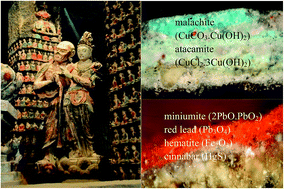Identification of the authenticity of pigments in ancient polychromed artworks of China†
Abstract
In order to identify the authenticity and to find the difference of pigments used in the south and north parts of China, on ancient Chinese artworks, painted samples were collected from different ancient grottos, tombs and architecture from the Tang dynasty (AD 618–907) and the Ming dynasty (1368–1644) and these were evaluated by comparison with pure pigments mostly used in ancient artworks. A total of 23 ancient green, red, blue, black and white pigmented samples were collected from the Guangyuan Thousand Buddha Grotto (AD 618–907), Da Yun Cave (AD 618–907), Emperor Li Shimin Tomb (AD 599–649) and Bell Tower (AD 1368–1644) and were analyzed using X-ray diffraction, Fourier transform infrared spectroscopy and scanning electron microscope with energy dispersive X-ray spectroscopy. Furthermore, each sample was analyzed for the presence of the 24 main elements using inductively coupled plasma emission spectrometry to understand the main contribution of the elements to the color, especially in the mixtured pigments. Among the 23 ancient painted samples, the main red pigments are miniumite (2PbO·PbO2), hematite (Fe2O3) and cinnabar (HgS), white pigments are anglesite (PbSO4), zinc white (ZnO) and gypsum (CaSO4·2H2O), green pigments are malachite (CuCO3·Cu(OH)2) and atacamite (CuCl2·3Cu(OH)2), and blue pigments are cobalt blue (CoO·Al2O3), chrysocolla ((Cu,Al)2H2Si2O5(OH)4·nH2O) and lazurite (Na3Ca(Si3Al3)O12S). In many cases, the painted colors are made of a mixture of pigments. It was revealed that six samples of GB-W (white), BT-W (white), GB-B (blue), DY-BLK (black), GB-G2 (green) and LS-BLK (black) were not in their original or pure form, and so they might have been repainted in the recent past, and possibly been retouched with modern colors. It is believed that the proposed analytical approach provides a bright future for the identification of original and fake painted artwork.



 Please wait while we load your content...
Please wait while we load your content...